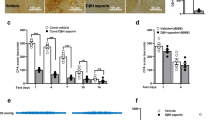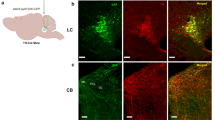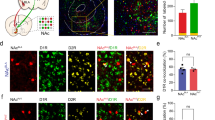Abstract
Noxious stimuli have motivational power and can support associative learning, but the neural circuitry mediating such avoidance learning is poorly understood. The anterior cingulate cortex (ACC) is implicated in the affective response to noxious stimuli and the motivational properties of conditioned stimuli that predict noxious stimulation. Using conditioned place aversion (CPA) in rats, we found that excitatory amino acid microinjection into the ACC during conditioning produces avoidance learning in the absence of a peripheral noxious stimulus. Furthermore, microinjection of an excitatory amino acid antagonist into the ACC during conditioning blocked learning elicited by a noxious stimulus. ACC lesions made after conditioning did not impair expression of CPA. Thus, ACC neuronal activity is necessary and sufficient for noxious stimuli to produce an aversive teaching signal. Our results support the idea that a shared ACC pathway mediates both pain-induced negative affect and a nociceptor-driven aversive teaching signal.
This is a preview of subscription content, access via your institution
Access options
Subscribe to this journal
Receive 12 print issues and online access
$209.00 per year
only $17.42 per issue
Buy this article
- Purchase on Springer Link
- Instant access to full article PDF
Prices may be subject to local taxes which are calculated during checkout



Similar content being viewed by others
Change history
14 March 2004
appended aop PDF with erratum PDF (will be corrected for print issue), updated Figure 2, and placed footnote in SGML at all occurrences of Figure 2
Notes
*Note: In the version of this article initially published online, the y-axis label in Fig. 2a is incorrect. The correct label should be (pre-conditioning -- post-conditioning). This error has been corrected for the HTML and print versions of this article.
References
Kandel, E., Schwartz, J. & Jessel, T. Principles of Neural Science (McGraw-Hill, New York, 2000).
LeDoux, J.E. Emotion circuits in the brain. Annu. Rev. Neurosci. 23, 155–184 (2000).
Quirk, G.J., Repa, C. & LeDoux, J.E. Fear conditioning enhances short-latency auditory responses of lateral amygdala neurons: parallel recordings in the freely behaving rat. Neuron 15, 1029–1039 (1995).
Rosenkranz, J.A. & Grace, A.A. Dopamine-mediated modulation of odour-evoked amygdala potentials during pavlovian conditioning. Nature 417, 282–287 (2002).
Fields, H.L. Pain: an unpleasant topic. Pain 6 (Suppl.), S61–S69 (1999).
Vogt, B.A. & Sikes, R.W. The medial pain system, cingulate cortex, and parallel processing of nociceptive information. Prog. Brain Res. 122, 223–235 (2000).
Price, D.D. Psychological and neural mechanisms of the affective dimension of pain. Science 288, 1769–1772 (2000).
Treede, R.D., Kenshalo, D.R., Gracely, R.H. & Jones, A.K. The cortical representation of pain. Pain 79, 105–111 (1999).
Casey, K.L. Forebrain mechanisms of nociception and pain: analysis through imaging. Proc. Natl. Acad. Sci. USA 96, 7668–7674 (1999).
Cliffer, K.D., Burstein, R. & Giesler, G.J. Jr. Distributions of spinothalamic, spinohypothalamic, and spinotelencephalic fibers revealed by anterograde transport of PHA-L in rats. J. Neurosci. 11, 852–868 (1991).
Peschanski, M. & Ralston, H.J. 3rd. Light and electron microscopic evidence of transneuronal labeling with WGA-HRP to trace somatosensory pathways to the thalamus. J. Comp. Neurol. 236, 29–41 (1985).
Berendse, H.W. & Groenewegen, H.J. Restricted cortical termination fields of the midline and intralaminar thalamic nuclei in the rat. Neuroscience 42, 73–102 (1991).
Sikes, R.W. & Vogt, B.A. Nociceptive neurons in area 24 of rabbit cingulate cortex. J. Neurophysiol. 68, 1720–1732 (1992).
Hsu, M.M. & Shyu, B.C. Electrophysiological study of the connection between medial thalamus and anterior cingulate cortex in the rat. Neuroreport 8, 2701–2707 (1997).
Craig, A.D. Pain mechanisms: labeled lines versus convergence in central processing. Annu. Rev. Neurosci. 26, 1–30 (2003).
Rainville, P., Duncan, G.H., Price, D.D., Carrier, B. & Bushnell, M.C. Pain affect encoded in human anterior cingulate but not somatosensory cortex. Science 277, 968–971 (1997).
Hutchison, W.D., Davis, K.D., Lozano, A.M., Tasker, R.R. & Dostrovsky, J.O. Pain-related neurons in the human cingulate cortex. Nat. Neurosci. 2, 403–405 (1999).
Koyama, T., Tanaka, Y.Z. & Mikami, A. Nociceptive neurons in the macaque anterior cingulate activate during anticipation of pain. Neuroreport 9, 2663–2667 (1998).
Yamamura, H. et al. Morphological and electrophysiological properties of ACCx nociceptive neurons in rats. Brain Res. 735, 83–92 (1996).
Foltz, E.L. & White, L.E. Pain relief by frontal cingulumotomy. J. Neurosurg. 19, 89–100 (1962).
Hurt, R.W. & Ballantine, H.T. Jr. Stereotactic anterior cingulate lesions for persistent pain: a report on 68 cases. Clin. Neurosurg. 21, 334–351 (1974).
Allen, G.V. & Hopkins, D.A. Mamillary body in the rat: topography and synaptology of projections from the subicular complex, prefrontal cortex, and midbrain tegmentum. J. Comp. Neurol. 286, 311–336 (1989).
Cassell, M.D. & Wright, D.J. Topography of projections from the medial prefrontal cortex to the amygdala in the rat. Brain Res. Bull. 17, 321–333 (1986).
Christie, M.J., Summers, R.J., Stephenson, J.A., Cook, C.J. & Beart, P.M. Excitatory amino acid projections to the nucleus accumbens septi in the rat: a retrograde transport study utilizing D[3H]aspartate and [3H]GABA. Neuroscience 22, 425–439 (1987).
Reep, R.L. & Corwin, J.V. Topographic organization of the striatal and thalamic connections of rat medical agranular cortex. Brain Res. 841, 43–52 (1999).
Gabriel, M., Kubota, Y., Sparenborg, S., Straube, K. & Vogt, B.A. Effects of cingulate cortical lesions on avoidance learning and training-induced unit activity in rabbits. Exp. Brain Res. 86, 585–600 (1991).
Salamone, J.D., Cousins, M.S. & Snyder, B.J. Behavioral functions of nucleus accumbens dopamine: empirical and conceptual problems with the anhedonia hypothesis. Neurosci. Biobehav. Rev. 21, 341–359 (1997).
Johansen, J.P., Fields, H.L. & Manning, B.H. The affective component of pain in rodents: direct evidence for a contribution of the anterior cingulate cortex. Proc. Natl. Acad. Sci. USA 98, 8077–8082 (2001).
Peretz, E. The effects of lesions of the anterior cingulate cortex on the behavior of the rat. J. Comp. Physiol. Psychol. 53, 540–548 (1960).
Ploghaus, A. et al. Dissociating pain from its anticipation in the human brain. Science 284, 1979–1981 (1999).
Takenouchi, K. et al. Emotional and behavioral correlates of the anterior cingulate cortex during associative learning in rats. Neuroscience 93, 1271–1287 (1999).
Nishijo, H. et al. Single neuron responses in the monkey anterior cingulate cortex during visual discrimination. Neurosci. Lett. 227, 79–82 (1997).
Gigg, J., Tan, A.M. & Finch, D.M. Glutamatergic excitatory responses of anterior cingulate neurons to stimulation of the mediodorsal thalamus and their regulation by GABA: an in vivo iontophoretic study. Cereb. Cortex 2, 477–484 (1992).
Puig, S. & Sorkin, L.S. Formalin-evoked activity in identified primary afferent fibers: systemic lidocaine suppresses phase-2 activity. Pain 64, 345–355 (1996).
Dubuisson, D. & Dennis, S.G. The formalin test: a quantitative study of the analgesic effects of morphine, meperidine, and brain stem stimulation in rats and cats. Pain 4, 161–174 (1977).
Pastoriza, L.N., Morrow, T.J. & Casey, K.L. Medial frontal cortex lesions selectively attenuate the hot plate response: possible nocifensive apraxia in the rat. Pain 64, 11–17 (1996).
Vaccarino, A.L. & Melzack, R. Analgesia produced by injection of lidocaine into the anterior cingulum bundle of the rat. Pain 39, 213–219 (1989).
Donahue, R.R., LaGraize, S.C. & Fuchs, P.N. Electrolytic lesion of the anterior cingulate cortex decreases inflammatory, but not neuropathic nociceptive behavior in rats. Brain Res. 897, 131–138 (2001).
Morgan, M.A. & LeDoux, J.E. Differential contribution of dorsal and ventral medial prefrontal cortex to the acquisition and extinction of conditioned fear in rats. Behav. Neurosci. 109, 681–688 (1995).
Barros, D.M. et al. Molecular signaling pathways in the cerebral cortex are required for retrieval of one-trial avoidance learning in rats. Behav. Brain Res. 114, 183–192 (2000).
Kung, J.C., Su, N.M., Fan, R.J., Chai, S.C. & Shyu, B.C. Contribution of the anterior cingulate cortex to laser-pain conditioning in rats. Brain Res. 970, 58–72 (2003).
Hardy, S.G. Analgesia elicited by prefrontal stimulation. Brain Res. 339, 281–284 (1985).
Hardy, S.G. & Haigler, H.J. Prefrontal influences upon the midbrain: a possible route for pain modulation. Brain Res. 339, 285–293 (1985).
Lee, D.E., Kim, S.J. & Zhuo, M. Comparison of behavioral responses to noxious cold and heat in mice. Brain Res. 845, 117–121 (1999).
Calejesan, A.A., Kim, S.J. & Zhuo, M. Descending facilitatory modulation of a behavioral nociceptive response by stimulation in the adult rat anterior cingulate cortex. Eur. J. Pain 4, 83–96 (2000).
Buchanan, S.L. & Powell, D.A. Cingulate cortex: its role in Pavlovian conditioning. J. Comp. Physiol. Psychol. 96, 755–774 (1982).
Mao, J., Mayer, D.J. & Price, D.D. Patterns of increased brain activity indicative of pain in a rat model of peripheral mononeuropathy. J. Neurosci. 13, 2689–2702 (1993).
Wei, F., Li, P. & Zhuo, M. Loss of synaptic depression in mammalian anterior cingulate cortex after amputation. J. Neurosci. 19, 9346–9354 (1999).
Wei, F. & Zhuo, M. Potentiation of sensory responses in the anterior cingulate cortex following digit amputation in the anaesthetised rat. J. Physiol. 532, 823–833 (2001).
Manning, B.H. A lateralized deficit in morphine antinociception after unilateral inactivation of the central amygdala. J. Neurosci. 18, 9453–9470 (1998).
Acknowledgements
The authors thank I. Meng for valuable discussions throughout the course of this work. We also thank G. Hjelmstad, J. Levine, J. Mitchell and S. Nicola for reading this manuscript, and C. Evans and C. Bryant for assistance in the completion of this study. Supported by a United States Public Health Service grant NS 21445.
Author information
Authors and Affiliations
Corresponding author
Ethics declarations
Competing interests
The authors declare no competing financial interests.
Rights and permissions
About this article
Cite this article
Johansen, J., Fields, H. Glutamatergic activation of anterior cingulate cortex produces an aversive teaching signal. Nat Neurosci 7, 398–403 (2004). https://doi.org/10.1038/nn1207
Received:
Accepted:
Published:
Issue Date:
DOI: https://doi.org/10.1038/nn1207
This article is cited by
-
Electroacupuncture Alleviates Hyperalgesia and Anxiety-Like Behaviors in Pain Memory Model Rats Through Activation of GABAergic Neurons and GABA Receptor in the Rostral Anterior Cingulate Cortex
Molecular Neurobiology (2024)
-
Temporal pain processing in the primary somatosensory cortex and anterior cingulate cortex
Molecular Brain (2023)
-
Anterior cingulate cortex regulates pain catastrophizing-like behaviors in rats
Molecular Brain (2023)
-
Adrenergic signalling to astrocytes in anterior cingulate cortex contributes to pain-related aversive memory in rats
Communications Biology (2023)
-
A neural circuit for the suppression of feeding under persistent pain
Nature Metabolism (2022)



